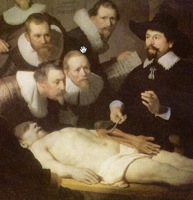Autopsy
Origin
Greek autopsia act of seeing with one's own eyes, from aut- + opsis sight, appearance
The term "autopsy" derives from the Ancient Greek autopsia, "to see for oneself", derived from αυτος (autos, "oneself") and όψις (opsis, "eye").
Definitions
- 1: an examination of a body after death to determine the cause of death or the character and extent of changes produced by disease —called also necropsy
- 2: a critical examination, evaluation, or assessment of someone or something past
Description
An autopsy—also known as a post-mortem examination, necropsy (particularly as to non-human bodies), autopsia cadaverum, or obduction—is a highly specialized surgical procedure that consists of a thorough examination of a corpse to determine the cause and manner of death and to evaluate any disease or injury that may be present. It is usually performed by a specialized medical doctor called a pathologist.
Autopsies are performed for either legal or medical purposes. For example, a forensic autopsy is carried out when the cause of death may be a criminal matter, while a clinical or academic autopsy is performed to find the medical cause of death and is used in cases of unknown or uncertain death, or for research purposes. Autopsies can be further classified into cases where external examination suffices, and those where the body is dissected and internal examination is conducted. Permission from next of kin may be required for internal autopsy in some cases. Once an internal autopsy is complete the body is reconstituted by sewing it back together.
Around 3000 BC ancient Egyptians were one of the first civilizations to practice the removal and examination of the internal organs of humans in the religious practice of mummification.
Autopsies that opened the body to determine the cause of death were attested at least in the early third millennium BC, although they were opposed in many ancient societies where it was believed that the outward disfigurement of dead persons prevented them from entering the afterlife (as with the Egyptians, who removed the organs through tiny slits in the body). Notable Greek autopsists were Erasistratus and Herophilus of Chalcedon, who lived in 3rd century BC Alexandria, but in general, autopsies were rare in ancient Greece. In 44 BC, Julius Caesar was the subject of an official autopsy after his murder by rival senators, the physician's report noting that the second stab wound Caesar received was the fatal one. By around 150 BC, ancient Roman legal practice had established clear parameters for autopsies.
The dissection of human remains for medical reasons continued to be practiced irregularly after the Romans, for instance by the Arab physicians Avenzoar and Ibn al-Nafis, but the modern autopsy process derives from the anatomists of the Renaissance. Giovanni Morgagni (1682–1771), celebrated as the father of anatomical pathology, wrote the first exhaustive work on pathology, De Sedibus et Causis Morborum per Anatomen Indagatis (The Seats and Causes of Diseases Investigated by Anatomy, 1769).
The great 19th-century medical researcher Rudolf Virchow, in response to a lack of standardization of autopsy procedures, established and published specific autopsy protocols (one such protocol still bears his name).[1]
